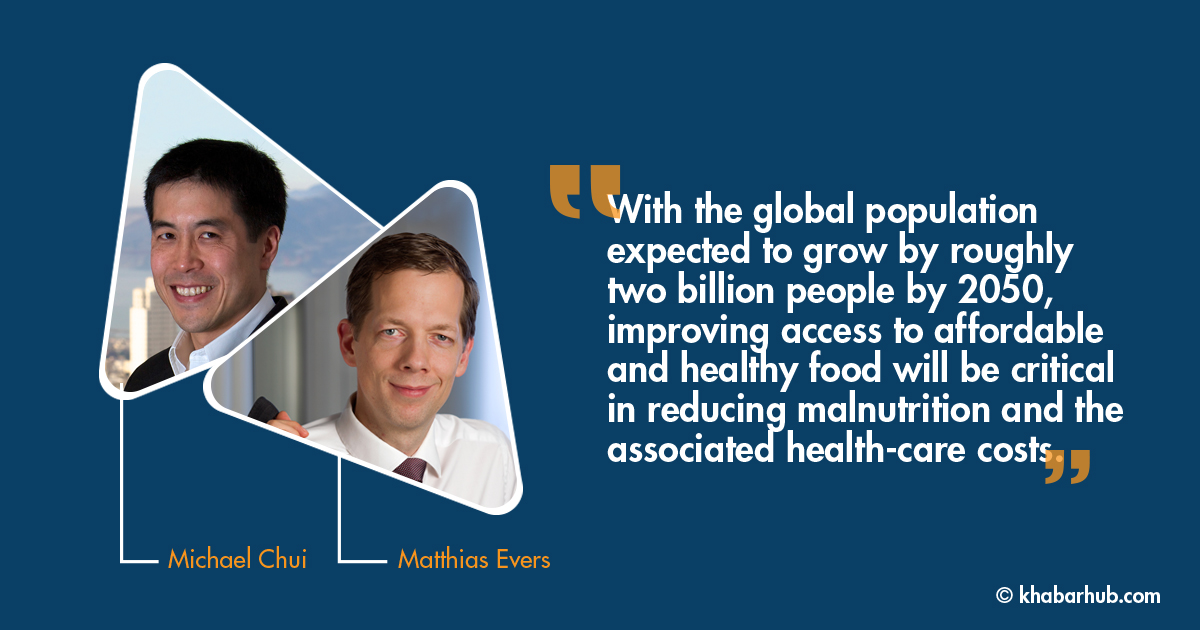In November, the United Nations World Food Program and the International Organization for Migration warned of the “unprecedented” threat to food security brought about by COVID-19.
The pandemic’s collateral damage could turn out to be even worse than the disease itself.
Most leading international institutions with an interest in food security have now called for action to prevent future outbreaks of infectious disease, and to make food systems more resistant to shocks.
Biological innovation must factor into our thinking as we strive to meet the dual challenge of feeding a growing population and managing natural resources sustainably.
Even before the pandemic, the Food and Agriculture Organization of the UN (FAO) warned that more than 820 million people did not have enough to eat.
With the global population expected to grow by roughly two billion people by 2050, improving access to affordable and healthy food will be critical in reducing malnutrition and the associated health-care costs.
Genetic editing to improve health and productivity in food animals such as dairy and beef cattle, swine, and poultry is still nascent, but interest in the field has soared since the 2019 outbreak of African swine fever.
Innovation in farming and food production is as old as agriculture itself, yet it is sorely needed today. Recent research by the McKinsey Global Institute finds that biological innovation in agriculture, aquaculture, and food production could yield economic returns of up to $1.2 trillion over the next decade or two.
To put that into context, the global food and agribusiness industry is worth about $5 trillion today.
What could deliver this growth? The most promising innovations include alternative proteins, marker-assisted breeding, genetic engineering of plant and animal traits, and microbiome mapping and modification.
Consumer interest in alternative protein sources is increasing globally, owing to concerns about health, the environment, and animal welfare.
Plant-based meat substitutes are already widely sold, though the economics of their production needs to be improved. Plant-based milk, for example, accounts for 15% of retail milk sales in the United States and 8% in Britain.
And companies like Clara Foods are using advanced yeast engineering and fermentation technologies to produce animal-free egg-white proteins.
Likewise, cultured meat and seafood – whereby muscle tissue grown from cells in the lab is made to mimic the protein profile of animal meat – is on the horizon. Earlier this month, Singapore became the first government to approve the sale of lab-grown meat (cultured chicken created by the San Francisco-based company Eat Just).
Over the next ten years, cultured meat and seafood could become cost competitive with conventional animal proteins.
Selective breeding of plants and animals is not new, but marker-assisted breeding has made the process cheaper and significantly faster, because it enables the selection of desirable traits even if the precise genes that generate them have not yet been identified or understood.
The plunging cost of DNA sequencing means that thousands of potential markers can be detected simultaneously. Whereas developing new crop varieties previously could require 25 years, it now can be done in as few as seven.
And because marker-assisted selection is not yet as prevalent in developing countries as it is in advanced economies, there are significant opportunities for growth.
Since the development of the first genetically engineered plant (tobacco) in the early 1980s, genetic engineering has become well established.
But, again, the technology is still improving rapidly. New tools like CRISPR have made gene editing more precise, allowing for crops to be tailored much more effectively to local conditions such as temperature and soil type.
CRISPR-edited produce could land on grocery store shelves in the US over the next ten years, starting with sweeter strawberries that have a longer shelf life.
Climate change reinforces the need for biological innovations, such as crops that have been engineered to withstand severe weather, or to grow in new environments, including areas with extreme temperatures, high salinity, or frequent droughts.
Another promising area of innovation is portable DNA-sequencing devices, which could soon be used by farmers to diagnose plant diseases, possibly improving quality and yield while eliminating or reducing use of pesticides.
Genetic editing to improve health and productivity in food animals such as dairy and beef cattle, swine, and poultry is still nascent, but interest in the field has soared since the 2019 outbreak of African swine fever.
Similarly, the mapping of the microbiome – including bacteria, fungi, and viruses – is helping researchers find ways to increase the resilience of crops, animals, and soil to drought and disease.
Here, too, advances in computing and sequencing are accelerating the pace of discovery, such that the biotech company Novozymes is already offering genetically engineered microbes to use in place of yield- and quality-boosting chemicals.
Many of these biological innovations can help us address not only hunger but also resource depletion and broader climate risks.
According to the FAO, raising livestock for meat, eggs, and milk generates 14.5% of global greenhouse-gas emissions; and one-third of all cropland is used to produce animal feed.
Agriculture is also the largest contributor to deforestation, occupying 43% of the world’s ice-free and desert-free land. The plant-based “Impossible Burger” embodies 89% fewer emissions than a traditional beef burger.
The first wave of commercially available genetically engineered products has not yet reached many countries, and 19 EU member states still support partial or full bans on their sale. In Africa, genetically modified food products are legal in only a tiny handful of countries.
Climate change reinforces the need for biological innovations, such as crops that have been engineered to withstand severe weather, or to grow in new environments, including areas with extreme temperatures, high salinity, or frequent droughts.
Many innovations are already contributing to food security, and the full potential of affordable DNA sequencing and CRISPR technology will continue to be revealed over time. It will take longer for lab-grown meat to make inroads, but when it does, the impact is likely to be felt far and wide.
Regulation and public perceptions have long played a role – both positive and negative – in biological innovation.
The first wave of commercially available genetically engineered products has not yet reached many countries, and 19 EU member states still support partial or full bans on their sale. In Africa, genetically modified food products are legal in only a tiny handful of countries.
Safety is clearly paramount. But if regulators and consumers’ concerns can be addressed, the bio-revolution could take us a long way toward tackling global challenges like food security and climate change.
(Michael Chui is a partner at the McKinsey Global Institute, specializing in big data. Matthias Evers is a senior partner in McKinsey’s Hamburg office and co-leads the firm’s global research and development work in the pharmaceutical and medical products practice)
Copyright: Project Syndicate, 2020









Comment